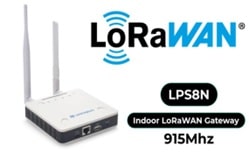Home »
IoT (Internet of Things) Tutorial
LoRaWAN: What It Is, Features, Applications, Working
LoRaWAN: In this tutorial, we will learn what is LoRaWAN, its key features, how LoRaWAN works, and its applications.
By Shahnail Khan Last updated : September 23, 2023
Considering LoRaWAN for deploying the IoT solution is a good choice. Operating on unlicensed frequencies and offering extended communication ranges, it has captured the interest of industries seeking efficient and cost-effective connectivity solutions. In this article, we will get to know about the LoRaWAN.

What is LoRaWAN?
LoRaWAN is a low-power, wide-area networking protocol based on the LoRa radio modulation technology. It wirelessly connects devices to the internet and controls communication between end-node devices and network gateways. The LoRaWAN network plays a major role in the development of smart cities and industries as it is an affordable long-range, bi-directional communication protocol with very low power consumption. For deploying a network, it uses an unlicensed ISM (Industrial, Scientific, and Medical) radio channel.
LoRaWAN: Key Features
Long Range Wide Area Network, or LoRaWAN, is a wireless communication technology with several characteristics and applications. The key features include-
- Long Range: LoRaWAN can connect devices up to 30 miles apart in rural regions and can penetrate dense urban or deep interior environments, making it excellent for long-range communication applications.
- Low Power: This networking protocol is designed to operate with less power, allowing devices to have longer battery life, which is critical for IoT (Internet of Things) applications where replacing batteries regularly is impractical.
- Secure Data Transmission: LoRaWAN uses 128-bit encryption on every transmission to secure data, similar to cellular and VPN networks.
- Standardization: LoRaWAN adheres to industry standards, ensuring compatibility and interoperability across various devices and networks.
- Modulation: It employs a particular modulation technique that enables long-range communication while conserving power.
- Capacity: LoRaWAN can handle a large number of devices at the same time, making it suited for applications with a large number of linked devices.
- Battery Efficiency: Due to its low-power nature, devices connected to LoRaWAN networks can operate on battery power for an extended period, reducing maintenance efforts.
Applications of LoRaWAN
LoRaWAN is flexible and is used in a variety of industries, including smart cities for environmental monitoring, waste management, and traffic control; agriculture to track soil conditions, weather data, and livestock; logistics to monitor assets, cargo, and streamline supply chains; utilities to collect data from smart metres for electricity, water, and gas; and healthcare for remote patient monitoring and tracking medical equipment.
How LoRaWAN Works?
LoRaWAN runs on unlicensed frequencies, often utilizing lower frequency ranges than the 2.4 or 5.8 GHz ISM bands. This choice of frequency offers greater communication ranges and improved signal penetration even when there are barriers.
LoRaWAN devices connect with LoRaWAN gateways located nearby. A LoRaWAN gateway receives LoRa-modulated RF signals from any end device within hearing distance and transmits the data to the LoRaWAN network server (LNS). An end device and a gateway do not always work together. Instead, multiple gateways can serve the same sensor. Each uplink packet delivered by the end device will be received by all gateways within range using LoRaWAN. The data is subsequently transferred from the devices through these gateways and sent to a central network server. This central server is critical in processing and managing data. The data may then be accessed by users and various applications after being processed by the server. This accessibility is frequently accomplished through cloud services or other network connections, making the data available for analysis, monitoring, or other uses.
Conclusion
In conclusion, LoRaWAN's long-range capabilities, low power consumption, and secure data transfer make it a flexible technology with applications spanning from smart cities to IoT deployments, providing a dependable and affordable option for wireless communication in numerous sectors.
Advertisement
Advertisement